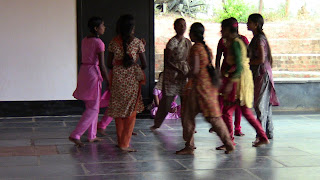At one point during this adventure, I felt like I had always been here. I'm not saying that I'm Indian, or that I fully understand the issues of the Indian people. I meant that as I spent more time here I remembered less and less about America. I find it harder to visualize a place where cows don't have the right of way; where I don't feel like you're breathing more dust than air; where I can't pick coconuts and bananas right from the trees; and where anything that has a neutral color is an oddity. I can't imagine days without teatime at 11 and 3, without having to fear for my mortal soul as I try to navigate the roads, without bats flying overhead in the twilight and dogs howling in one long symphony at the midnight hour. It is hard to believe that there is a place where people drink cold water with ice cubes; instead of the people in Wayanad who drink their water scalding and dye the water pink with a special root, so that you know it is boiled.
Tomorrow though, I am going back to that place. In 12 hours I will board a plane that will take back to Iowa City, where I will go back to my life of hanging out with my friends, going to school, eating hamburgers, enjoying hot showers, surfing the internet anytime I want, enjoying electricity that never goes out, going to Best Buy, and playing "Space Marine" on my Xbox. And all of these things are fine. People should do what they think is best. People should try and be happy. But are we happy? Obviously it is better to have clean water, constant electricity, good healthcare, hygienic food, and sane traffic regulations. But I keep thinking of my visits to the slums and the mall. I keep thinking about the eyes of people in the mall. They all seemed like hollow people, with eyes that stared at nothing. And then I think of the people in the slums and I think that those people, even though impoverished, had life. They had humanity. I have no doubt that in a second the people in the slums would switch roles with the people in the mall, but I would be curious to see what effect the change would have on them, whether they would also lose their souls.
I have to classify most American tourists into two categories. The first category I call the "Grateful Americans." These are the people who, after two weeks in a country, have learned that it is a very fine thing to be an American, and that they should remain wealthy at all costs. I fall under this category. The second group I call the "Britta's" of the world. These people spend two weeks abroad and feeling that they should appear righteously indignant at the injustice of the world, announce that they would love nothing more than to abandon America and move into some small tribal hut living among the natives. These people are hysterical because of the them are either A.) liars or B.) fools. People who truly wish to live in another country typically don't announce their plans so that everyone and their grandmother can hear. They just do it. At Visthar, the resident artist was an artist named Francoise. Francoise makes dolls and exhibits them to raise awareness about social issues. Her exhibits go on display all around the world. She has lived in India for 40 years. She just came to India and never left.
I think that most Americans who travel are blind people. I feel that when they travel they look but they do not see. They do not understand what is being shown to them. I do not write this because I can see. I write this because I am also blind. I write because I know that I will always travel in a state of ignorance. To pretend otherwise is insanity. No matter how often to you travel, how long you spend in a foreign country, you cannot truly comprehend it. In order to understand every culture in the world you would have to live a many lives, with many faces, but always you.
I suppose this inability to understand everything has caused me to question why I travel, why I go to places like India, and why I still want to see the three contents I haven't yet visited. There are two reasons. The first reason is that I love stories. I love listening to them. Talking with the Adivasi taught me that everyone has a story, that people want to tell their stories, and that if you are lucky enough for someone to be willing to tell their story, you should treasure it. The second reason is that we live in an age when adventures are becoming a limited resource. There are no more worlds to explore. People do not seem interested anymore in leaving the comfort of their world, unless it is to go on a bar crawl in Europe. I keep feeling that we are becoming a nation of hobbits, but not in a good way.
I have learned a lot about myself. Perhaps that's why people should travel. Perhaps by going to someplace else, you're able to see things back home differently. You're able to have to have some perspective on your own problems, about what you value and don't value. In the end all it is is what you make of it.







